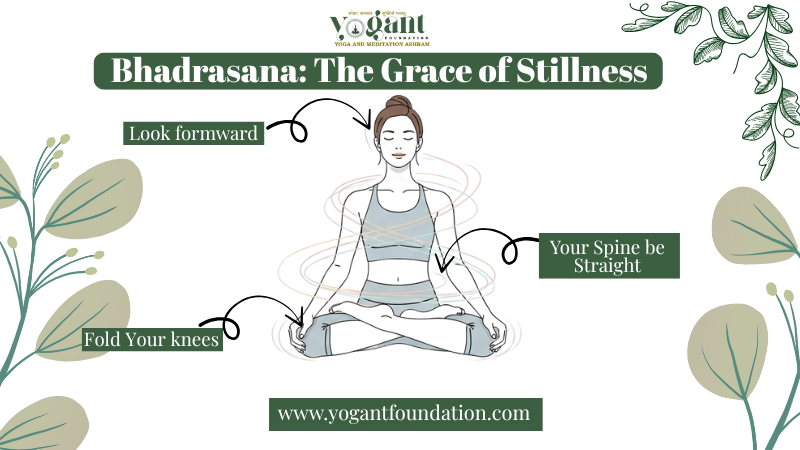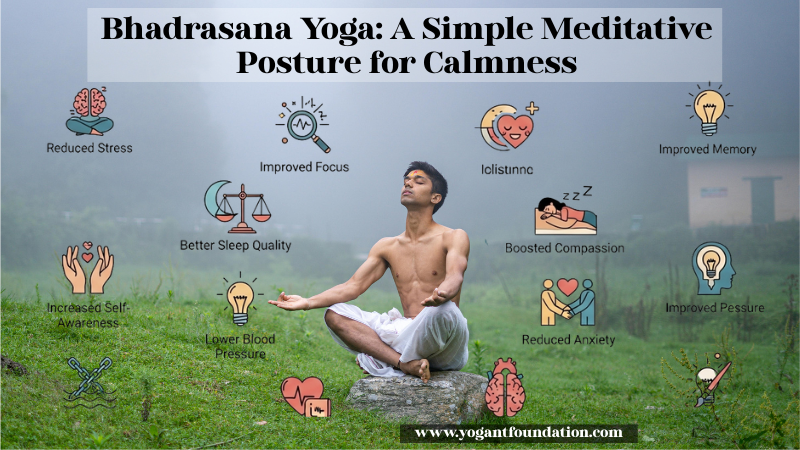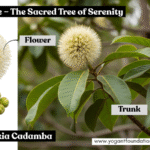Introduction to Bhadrasana
Bhadrasana, also known by the names the Gracious Poses or Butterfly Pose, is an effective yet simple asana that promotes inner peace, tranquility, and stability. The Sanskrit word “Bhadra” is auspicious. Gracious represents the peaceful and sacred energy this posture brings. It’s a meditative position which is often used with Pranayama Dhyana or meditation as well as mantra chanting.
As you practice Bhadrasana, it helps relieve tension and open the hips. It also increases flexibility, Digestion, as well as the ability to move around. The pose is suitable for advanced and beginner yoga practitioners.
Meaning and Origin of Bhadrasana
The Sanskrit term Bhadrasana comes from the following two words:
- Bhadra (भद्र)– meaning auspicious, blessed, or gracious
- Asana (आसन)– meaning posture or seat
Thus, Bhadrasana means “Auspicious Seat” or “Gracious Pose. “”
Bhadrasana was described by ancient yogic works like the Hatha Yoga Pradipika and Gheranda Samhita as a meditative pose that is best for concentration.
Guide on How to Do Bhadrasana
Bhadrasana emphasizes relaxation, stillness, and calm. For it to be performed correctly, you must follow the steps below:
Step 1: Starting Position
- Sit with your feet extended in front of your mat.
- Relax your shoulders and spine.
Step 2: Bend Your Knees
- Slowly bring both feet to your pelvis.
- Make sure the soles of your feet are touching each other.
Steps 3: Hold the Feet
- Keep both feet tightly together by using your hands.
- Bring your feet closer together without straining.
Step 4: Position of the Thighs and Knees
- Drop your knees towards the ground.
- Allow gravity to do its work.
Steps 5: Straightening Your Spine
- Your spine should be straight. Keep your chest out.
- You can close your eyes and concentrate on your breath.
Step 6: Breathing & Awareness
- Slowly and deeply inhale.
- Your inner thighs or hips should feel stretched.
- This position can be maintained for 1 – 3 minutes by beginners or up to 10 minutes by advanced practitioners.
Guidelines for Safe Bhadrasana Practice
- You should not push down on your knees with force.
- Sit down on a cushion to ease your tight hips.
- Maintain a straight spine.
- You can practice either on an empty abdomen or up to 4 hours after a meal.
- Take a deep breath and breathe evenly.
Bhadrasana: Preparatory Poses
You can warm your hips up with gentle poses prior to attempting Bhadrasana.
You can also try:
- Sukhasana (Easy Pose)
- Vajrasana (Thunderbolt Pose)
- Butterfly Flaps (Titli Asana)
- Upavistha Konasana (Seated Wide-Angle Pose)
These postures prepare the hips & thighs for Bhadrasana by loosening the lower body.
Follow-up Poses After Gracious Pose
If you are feeling more relaxed, try a deeper meditation or relaxation pose such as
- Padmasana (Lotus Pose)
- Ardha Padmasana (Half Lotus Pose)
- Savasana (Corpse Pose)
- Dhyana (Meditation)
Notice the benefits of Bhadrasana
Bhadrasana practice regularly has several physical, spiritual, and mental benefits. There are numerous. Let’s look at them more closely:
1. It improves hip flexibility
Bhadrasana is a gentle stretch that improves the flexibility and mobility of the hips. The groin area and the knees.
2. Pelvic Muscles Strengthening
It is highly beneficial for man and woman. Also, it supports reproductive health.
3. Enhances Digestion
Gracious Pose increases Digestion ( AGNI ) by improving the circulation of the abdominal area. It also relieves bloating and constipation.
4. Calms Mind
Gracious Pose, as a meditative pose, calms down the body, concentrates the mind, and reduces stress, anxiety, and restlessness.
5. Meditation and Pranayama support
With its upright spine and stable foundation, it is perfect for Meditation and Pranayama.
6. Menstrual Discomfort is relieved by this product
Gracious Pose reduces cramps and discomfort caused by menstruation, as it relaxes pelvic muscles and increases blood flow.
7. Improved Posture
As you sit in this pose regularly, your posture and spinal alignment will improve.
Therapeutic applications of Bhadrasana
If you suffer from anxiety or depression, try these:
Gracious Pose, with its soothing properties that promote relaxation and help regulate the nervous system, is an excellent natural treatment for anxiety or mild depression.
In Reproductive Health
Gracious Pose helps to strengthen and relax the pelvic muscles. It is beneficial to people dealing with problems related to fertility, menstrual irregularities.
For Digestion:
This stimulates the digestive system and helps with smooth bowel movement.
Cautions and contraindications
Though Gracious Pose can be performed safely in most cases, it is important to exercise caution when certain conditions arise.
- Avoid this if your knees or hips are severely injured.
- After an abdominal or pelvic surgery, you should not practice immediately.
- Every pregnant woman must work with an instructor.
- When you feel sharp pains or numbness in your hands, you should immediately stop.
Bhadrasana Meditation and Connection
Gracious Pose, which has the effect of grounding you down, is popular among yogis. The Prana can flow freely throughout the body when you are in this posture. A steady position helps deepen Dhyana.
You can combine Gracious Pose practice with Pranayama, like:
- Anulom Vilom (Alternate Nostril Breathing)
- Bhramari (Bee Breath)
- Nadi Shodhana (Channel Purification)
Bhadrasana Texts in Yogic Texts
Bhadrasana’s meditative power has long been recognized by ancient yogic literature.
Hatha Yoga Pradipika (Verse 1.55-56)
Maintain your body in a stable position and press the perineum gently with the heels. The practitioner’s mind will become calm, and they will achieve peace.
This verse highlights Bhadrasana’s significance for Stability, Concentration Inner Peace.

Bhadrasana and its Spiritual Significance
In yoga, it is believed that the hips contain emotions and energies.
Gracious Posecan help release trapped emotions, thus allowing the prana energy to flow through Muladhara (Root Chakra ) and Swadhisthana freely.
Gracious Posecan help you to achieve emotional balance and accept yourself when performed mindfully.
Beginners’Beginners’ Modifications
It is possible to start with Gracious Pose.
- Placing a folded-up blanket or yoga block beneath your hips will help you relax.
- Your heels should be kept away from your inner thighs.
- Keep your knees supported with cushions.
- Gradually increase the duration of practice.
Bhadrasana, Advanced Variations
When you are comfortable with the basic variations, try these:
- Dynamic Flying Butterfly: Spread your legs out like butterfly wings.
- Bhadrasana, with Forward Bend: Bending forward will stretch your spine deeper and increase hip flexibility.
- Bhadrasana (Meditation): Assume the pose steadily and practice mindfulness while chanting and/or chanting mantras.
Daily Practice Routine
The following is an example of a routine that includes Gracious Pose:
- Start with Sukhasana.
- Move into Bhadrasana within 5 minutes.
- Practice Anulom Vilom Pranayama – 5 minutes.
- Savasana- 3 minutes.
This sequence will help you to achieve both physical calm and inner stillness.
Scientific view on Bhadrasana
Studies suggest that Gracious Pose and other sitting poses like it can improve:
- Activate the parasympathetic system to reduce stress
- Lower the Blood pressure
- Accelerate circulatory and joint movement
It is a bridge between ancient wisdom and the modern wellness sciences.
The Grace of Stillness
Bhadrasana (the Gracious Pose) teaches us how to remain calm, grounded, centered, and still. Not just a pose in yoga, it’s also a tranquil state. With regular practice, the asana brings body, soul, and mind into harmony.
Keep in mind: Bhadrasana does not depend on how much your knees fall, but instead on how deeply you can relax your mind.



